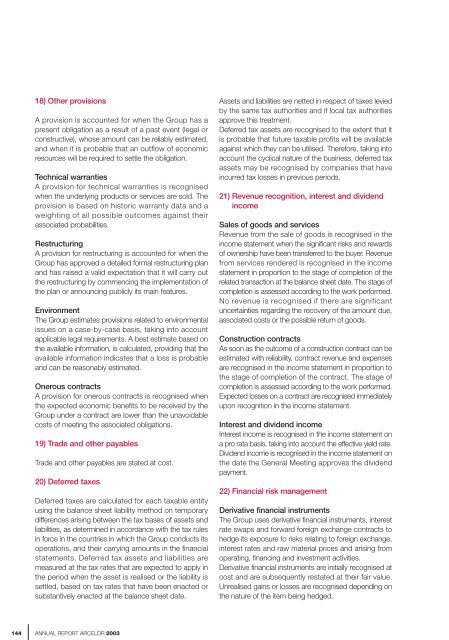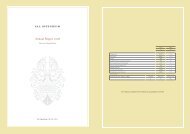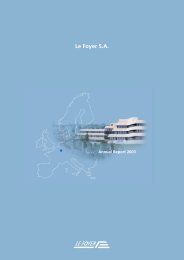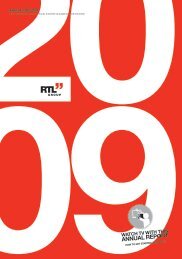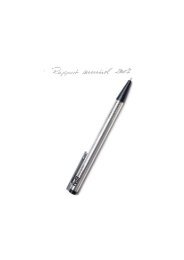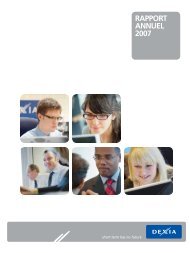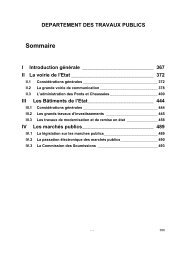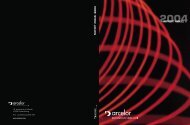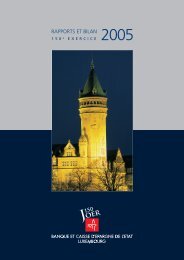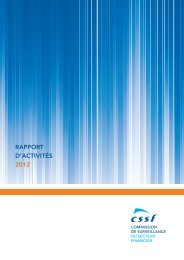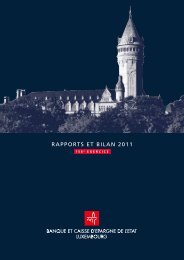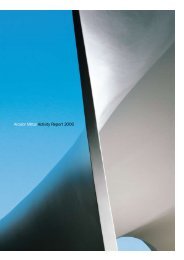ANNUAL REPORT ARCELOR 2003 - paperJam
ANNUAL REPORT ARCELOR 2003 - paperJam
ANNUAL REPORT ARCELOR 2003 - paperJam
You also want an ePaper? Increase the reach of your titles
YUMPU automatically turns print PDFs into web optimized ePapers that Google loves.
18) Other provisionsA provision is accounted for when the Group has apresent obligation as a result of a past event (legal orconstructive), whose amount can be reliably estimated,and when it is probable that an outflow of economicresources will be required to settle the obligation.Technical warrantiesA provision for technical warranties is recognisedwhen the underlying products or services are sold. Theprovision is based on historic warranty data and aweighting of all possible outcomes against theirassociated probabilities.RestructuringA provision for restructuring is accounted for when theGroup has approved a detailed formal restructuring planand has raised a valid expectation that it will carry outthe restructuring by commencing the implementation ofthe plan or announcing publicly its main features.EnvironmentThe Group estimates provisions related to environmentalissues on a case-by-case basis, taking into accountapplicable legal requirements. A best estimate based onthe available information, is calculated, providing that theavailable information indicates that a loss is probableand can be reasonably estimated.Onerous contractsA provision for onerous contracts is recognised whenthe expected economic benefits to be received by theGroup under a contract are lower than the unavoidablecosts of meeting the associated obligations.19) Trade and other payablesTrade and other payables are stated at cost.20) Deferred taxesDeferred taxes are calculated for each taxable entityusing the balance sheet liability method on temporarydifferences arising between the tax bases of assets andliabilities, as determined in accordance with the tax rulesin force in the countries in which the Group conducts itsoperations, and their carrying amounts in the financialstatements. Deferred tax assets and liabilities aremeasured at the tax rates that are expected to apply inthe period when the asset is realised or the liability issettled, based on tax rates that have been enacted orsubstantively enacted at the balance sheet date.Assets and liabilities are netted in respect of taxes leviedby the same tax authorities and if local tax authoritiesapprove this treatment.Deferred tax assets are recognised to the extent that itis probable that future taxable profits will be availableagainst which they can be utilised. Therefore, taking intoaccount the cyclical nature of the business, deferred taxassets may be recognised by companies that haveincurred tax losses in previous periods.21) Revenue recognition, interest and dividendincomeSales of goods and servicesRevenue from the sale of goods is recognised in theincome statement when the significant risks and rewardsof ownership have been transferred to the buyer. Revenuefrom services rendered is recognised in the incomestatement in proportion to the stage of completion of therelated transaction at the balance sheet date. The stage ofcompletion is assessed according to the work performed.No revenue is recognised if there are significantuncertainties regarding the recovery of the amount due,associated costs or the possible return of goods.Construction contractsAs soon as the outcome of a construction contract can beestimated with reliability, contract revenue and expensesare recognised in the income statement in proportion tothe stage of completion of the contract. The stage ofcompletion is assessed according to the work performed.Expected losses on a contract are recognised immediatelyupon recognition in the income statement.Interest and dividend incomeInterest income is recognised in the income statement ona pro rata basis, taking into account the effective yield rate.Dividend income is recognised in the income statement onthe date the General Meeting approves the dividendpayment.22) Financial risk managementDerivative financial instrumentsThe Group uses derivative financial instruments, interestrate swaps and forward foreign exchange contracts tohedge its exposure to risks relating to foreign exchange,interest rates and raw material prices and arising fromoperating, financing and investment activities.Derivative financial instruments are initially recognised atcost and are subsequently restated at their fair value.Unrealised gains or losses are recognised depending onthe nature of the item being hedged.144<strong>ANNUAL</strong> <strong>REPORT</strong> <strong>ARCELOR</strong> <strong>2003</strong>


